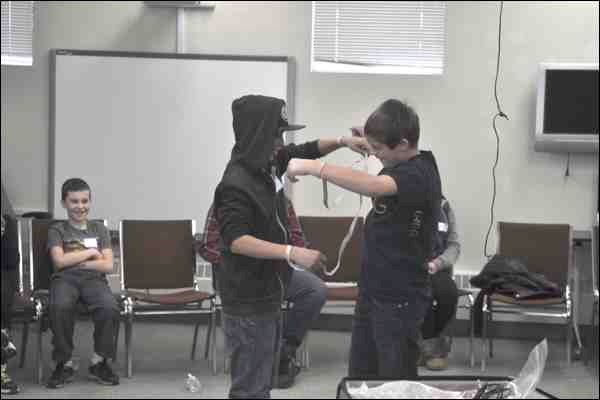Two schools - one from Battleford, the other from Mosquito First Nation - have teamed up to raise awareness about First Nations heritage and culture.
The Grade 7 class from St. Vital School spent the day Thursday alongside Grade 7 and 8 students from Mosquito Reserve School from Mosquito First Nation.
They spent the day together at the Allen Sapp Gallery, where the students took part in games and various educational activities focusing on the First Nation heritage.
The day came as a result of the schools' involvement in Free the Children and Me to We activities.
Free the Children sponsors an educational initiative called Together We Stand targeting awareness of aboriginal issues in Canada.
Students at St. Vital School were active in Me to We Day and, according to their teacher Kelly Waters, thought it would be a good idea to partner with a reserve school.
"We thought it might be interesting to take that to another level and have a partnership or a relationship with a reserve school," said Waters.
One of the students suggested contacting Free the Children to see if any nearby reserve schools might be interested. They contacted Mosquito Reserve School. Teacher Lamarr Oksasikewiyin responded, and the two schools agreed to form a partnership.
When the students converged on Allen Sapp Gallery, Thursday, the first hour was spent learning about and taking part in a "smudging" ceremony. That is the traditional activity where certain herbs are burned and people take the smoke in their hands and distribute it over their body.
The students also engaged in activities designed to increase their awareness of the Native culture. While in the gallery, the students viewed artwork of Allen Sapp and learned about his life story. Treaty education was also on the agenda.
Michelle Sanderson, Living Sky School Division's First Nations and Métis achievement consultant, said one of the activities that took place that morning had an anti-racism and anti-oppression focus.
"We had students kind of think about that and reflect on what they've experienced or heard of, and think of how they can interrupt that in their own lives," said Sanderson.
The idea was for students to "get to know each other, form some relationships, deal with some of our feelings and beliefs and attitudes around how we get along and engage in culture, and share through shared histories and stories that we have," said Sherron Burns, arts education consultant with Living Sky School Division, who took part in the day.
Oksasikewiyin noticed there was some trepidation by the students from the schools early on. Getting them to interact was a challenge at first.
"At first they were all nervous, they were hanging around each other," he said. "Then I noticed as the day progressed, even if it was just one morning, they were laughing with each other already."
Among the games was shooting turkey feathers at a toy buffalo that dangled from a string tied to the ceiling. But the students seemed most enthused by a game called double ball, a traditional Native ball game, Oksasikewiyin noted.
Lyndon Osecap, Grade 7 from Mosquito School, said the highlight for him was "when we were downstairs playing those games," he said.
The games also made an impression on Courtney Johnson, Grade 7 student from St. Vital. The one she found most interesting was the one where kids were tangled in "two pieces of rope, and they went around your wrists, and they were looped together and you had to try and untangle yourselves. It was really funny."
Many of the ideas for what took place that day came from input from students and the student leaders, the teachers say.
"It's not teacher-driven. We're here together because our students want it," said Oksasikeywin.
The activities fit in with treaty education and social history education, part of the education curriculum in Saskatchewan. It also served to bring about greater understanding.
"We're trying to bring down cultural barriers with the students, and racial barriers," said Sanderson. "The whole day is about bringing two groups of people together who really don't understand each other, haven't had much contact, and to make it so they're being integrated together by creating understanding."
The teachers say it would be a good idea for other schools to try a similar partnership. They also have some ideas about how to take the relationship between St. Vital and Mosquito schools further.
One idea is to have exchange students take classes at each other's schools for a day to experience a "day in the life" at the school.
Another is to look into exploring the idea of making a treaty between the schools. The teachers say these ideas will be looked into some more before they go ahead, but the idea behind it would be to help students understand the process of treaty making.




